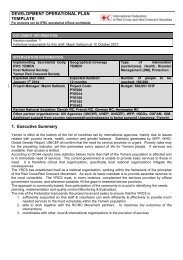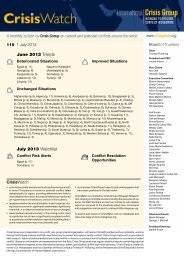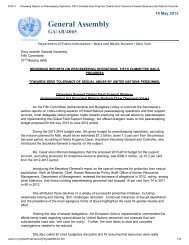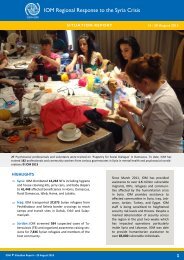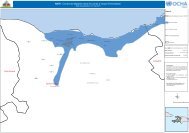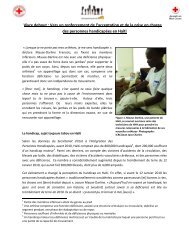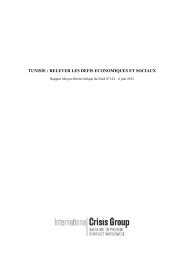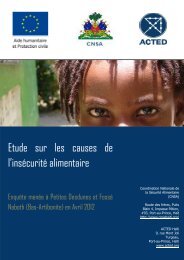SOMALI NUTRITION STRATEGY 2011 – 2013 - ReliefWeb
SOMALI NUTRITION STRATEGY 2011 – 2013 - ReliefWeb
SOMALI NUTRITION STRATEGY 2011 – 2013 - ReliefWeb
Create successful ePaper yourself
Turn your PDF publications into a flip-book with our unique Google optimized e-Paper software.
The results of the National Micronutrient<br />
and Anthropometric Nutrition survey 2009<br />
confirm this pattern of higher prevalence<br />
of stunting and wasting in South Central<br />
Somalia compared to Somaliland and<br />
Puntland (see figure 7). The meta analysis<br />
of data for 2010-2008 also reveals variation<br />
by region. Gedo region is the worst<br />
affected region across the country with a<br />
median acute malnutrition rate of 21.5%<br />
and a persistently Very Critical nutrition<br />
situation. Galgadud (18.4%), Bay (18.0%),<br />
Bakool (17.1%) and Hiran (16.7%) also<br />
show high median wasting rates over the<br />
period 2001-2008.<br />
Figure 7: Malnutrition rates by zone, according to National<br />
Anthropometric Micronutrient Survey results 2009<br />
prevalence (%)<br />
35<br />
30<br />
25<br />
20<br />
15<br />
10<br />
5<br />
0<br />
1.3<br />
4.1<br />
NEZ NWZ SCZ Combined<br />
5.9<br />
4<br />
10.7<br />
16.5<br />
13.9 13.9<br />
16.5<br />
19.5<br />
SAM GAM Stunting<br />
31.6<br />
23.2<br />
Source: FSNAU 2010<br />
45<br />
2.4 Micronutrient malnutrition<br />
Throughout Somalia the presence of risk factors for micronutrient malnutrition (poverty, poor<br />
access to food, low diet diversity, high morbidity) is high suggesting micronutrient deficiencies are a<br />
significant public health problem. The findings of MICS 2006 showed that only 1.2% of households<br />
use iodised salt while coverage of Vitamin A supplementation in children 6 to 59 months was<br />
24% but otherwise data on the extent of the problem was limited. In 2009 a national micronutrient<br />
and anthropometric nutrition survey was conducted to address the information gap and inform<br />
appropriate responses. The national two stage cluster survey was conducted in the three zones<br />
to determine the prevalence of vitamin A deficiency, Iron deficiency and anaemia in children 6-59<br />
months and women of reproductive age and iodine deficiency in school aged children and women.<br />
Information was also collected regarding infant feeding and care practices and anthropometric<br />
status. Field work was completed between March and August 2009, followed by laboratory analysis<br />
of samples.<br />
Results of the survey demonstrated the<br />
prevalence of both nutritional anaemia and<br />
vitamin A deficiency in women and children<br />
of all age groups are severe according to<br />
WHO classifications and therefore are of<br />
significant public health importance.<br />
Anaemia prevalence was 59.3% for children<br />
aged 6 to 59 months, 38.5% for school aged<br />
children, 46.6% for non pregnant women and<br />
49.1% for pregnant women. In children aged<br />
6 to 59 months, there was no significant<br />
difference in prevalence of anaemia between<br />
Testing for Anaemia, FSNAU<br />
the zones but rural children were found to be<br />
50% more at risk of developing anaemia than their urban counterparts. There was also a significant<br />
difference between prevalence of anaemia in children less than two years (73.7%) and those over<br />
two (51.9%).<br />
Findings for the prevalence of vitamin A deficiency indicate a severe situation according to the<br />
WHO classification of above 20% prevalence, across all zones and each group. Among children 6<br />
to 59 months, the overall prevalence of vitamin A deficiency was 33.3%, with a higher prevalence in<br />
South Central Somalia (40.7%) compared to Somaliland (25.6%) and Puntland (24.1%). Similarly,<br />
overall prevalence of vitamin A deficiency in school aged children was 31.9% and in women, 54.4%.




